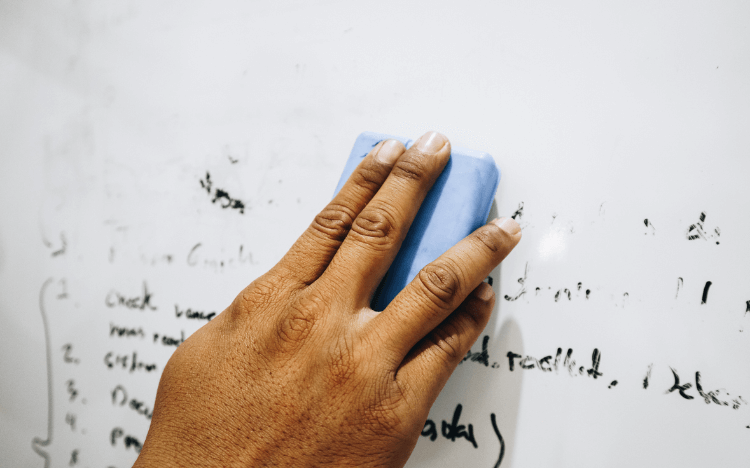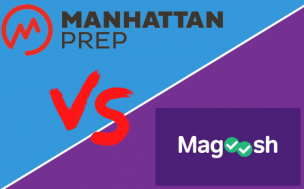With the onset of the COVID-19 pandemic, the Graduate Management Admission Council (GMAC) announced the creation of the GMAT Online Exam—a remote testing option aimed at making the GMAT more accessible by reducing reliance on brick-and-mortar testing centers.
The GMAT Online Exam has undergone multiple changes since its inception, including the switch to the GMAT Focus Edition and the admission of a physical whiteboard.
The physical whiteboard option allows you to customize your GMAT Focus Edition experience in a completely new way.
By learning all you can about the GMAT’s whiteboard options, practicing before test day, and mastering a few tricks, you’ll be well on your way to a comfortable and smooth test day.
Whiteboard options
When taking the online GMAT Focus Edition, you have three options: use the GMAT online whiteboard, use the GMAT physical whiteboard, or use both.
But first, a quick breakdown of the two whiteboards permitted on the GMAT Online Exam:
1. GMAT online whiteboard
While taking the online GMAT Focus Edition, you will be provided with an online “whiteboard” that you may use for scratch work and note-taking.
You may “write", using your computer’s trackpad or mouse (no touch screens or styli allowed), or by entering text into a text box. There are also tools for drawing and shading shapes.
You may keep your work as you go from problem to problem, or erase your screen. According to GMAC, the whiteboard is “almost an endless canvas”, which means that you may zoom and pan to maximize the space.
There is no need to opt in or out of this feature—it’s there if you want it and can be opened or closed with the click of a button at the top of your screen.
GMAC offers an online whiteboard for practice, so that you may get used to the features before the exam.
2. GMAT physical whiteboard
The physical whiteboard is a small dry-erase board that you may use while taking the exam. You are required to provide this whiteboard yourself, and it must meet all of GMAC’s specifications.
Specifications for the physical whiteboard on the GMAT Focus Edition
Searching “GMAT whiteboard Amazon” will bring up a variety of options (not all of which meet the exact GMAC criteria), so here’s a short list of recommended physical GMAT whiteboards for you to review.
Here are the GMAT whiteboard rules:
Size
● No larger than 12 ins x 20 ins or 30 cm x 43 cm (smaller is okay)
Physical whiteboard style
● In this case, “whiteboard” means a white dry-erase board
● White backgrounds only (no other colors, no gridlines, no markings whatsoever)
Physical whiteboard accessories
● Up to two dry-erase markers (any color or size)
● Up to one dry-erase whiteboard eraser (any size, can be on the marker cap or separate)
Physical whiteboard rules and FAQ
1. How will the proctor know if my whiteboard meets these specifications?
Before your exam, the proctor will ask to see your entire testing area (you must be alone in a walled room with a closed door and no distractions).
They will also ask to see your whiteboard, and you will have to prove that it was erased on both sides. Please note that the proctor will ask you to remove the whiteboard from the testing area if it does not meet all specifications.
2. How often will I need to erase my whiteboard?
The proctor will require you to begin your exam with a clean whiteboard. They will ask you to erase the board (both sides!), and show it to them, before your exam, during optional breaks (if you choose to take them), and after your exam ends.
Otherwise, you can erase as often as you want throughout the exam.
3. May I use a double-sided whiteboard?
Yes, double-sided whiteboards are permitted, but both sides must meet the specifications listed above (no larger than 12 ins x 20 ins, white, and no markings).
4. May I use napkins, paper towels, tissues, or a cloth to erase? What about whiteboard cleaning spray or water?
No, you must use a dry-erase whiteboard eraser only.
5. May I use permanent markers, pens, or pencils on my whiteboard?
No, you must use a dry-erase marker that can be erased.
6. May I use scratch paper instead of a whiteboard? May I use scratch paper in a clear slide with whiteboard markers? What about a chalkboard?
No, you may not use scratch paper, clear slides, or chalkboards for the online exam.

Pros and cons of using a physical whiteboard on the GMAT Focus Edition
As mentioned before, the introduction of the GMAT physical whiteboard was cause for celebration. Here's why.
Pros:
● Many students find it more intuitive, and faster, to write by hand than to use the GMAT’s online whiteboard option. The physical whiteboard can save you time. It also frees up brain space needed to focus on the exam questions, rather than on the functionality of the online whiteboard tool.
● It’s small, so you won’t waste time panning and zooming around the online whiteboard’s nearly endless space.
● The online GMAT exam can cause eye strain. Looking away from the screen to outline, jot down a note, or do a quick calculation gives your eyes a break. This can keep you from getting tired too fast.
● It’s extra space! If you opt to use both the online and physical whiteboards, you now have bonus space for scratch work.
● Rather than opening a whiteboard in a new window (and resizing screens to accommodate it), you can see your physical whiteboard while leaving your exam questions full-sized.
● The GMAT Focus Edition can be overstimulating. Being able to erase your whiteboard after each problem gives you a literal clean slate, which can help you focus and stay calm.
Cons:
● You’re limited by the size. Once it’s filled, you have to erase it.
○ Tip: Choose a whiteboard with a small border in order to maximize usable space.
○ Tip: Choose a marker with a fine tip.
● It’s difficult to save your work and come back to it, because your whiteboard will quickly fill up.
○ Tip: Use the online whiteboard for notes you want to keep from question to question (just remember not to erase the entire workspace!).
● Some students find erasing to be a hassle.
○ Tip: To make erasing easier, order a large whiteboard eraser, rather than using the small ones that come on dry erase marker caps. This will allow you to erase the entire board quickly (plus, the pen cap erasers rarely last very long before bending or smudging).
○ Tip: If you find that you frequently misplace your eraser, make sure you choose a magnetic dry erase board and a magnetic eraser. Keep them together.
○ Tip: Practice writing lightly so you have less ink to erase.
● If you have a small desk space, then you may find it difficult to manage a computer and a whiteboard.
○ Tip: Measure the free space on your desk before ordering your whiteboard, and then choose the size that works best for your workspace.
● If you have messy handwriting, find writing difficult, or find it challenging to organize your thoughts in writing, then the physical option may not be the right fit for you—and that’s okay, too!

Tips and tricks for making the most of your whiteboards
One very important note about all the cons that we just listed is that students have found solutions for all of them.
Taking advantage of the tips and hacks below will allow you to get the most out of the two whiteboards at your disposal, and save you time and energy on your GMAT exam.
1. Order your whiteboard, pens, and eraser as soon as possible
We’ve all heard that supply chains have been disrupted by the pandemic. If you want to order your supplies online, you may be facing longer than typical wait times before delivery. We don’t want test day to arrive before your whiteboard, so please order soon!
This will give you time to practice with your supplies, which is vital for ensuring a smooth test day experience. And if you absolutely hate something you ordered, you will have the chance to procure a different option.
2. Order extra pens
Sometimes pens arrive dry and won’t work well enough on test day. Also, dry-erase pens don’t have a long life span, so you may use up a few while practicing. It’s always better to have some backups.
3. Choose the right materials
Choosing a whiteboard with a thin border will allow you to maximize usable space.
Choosing markers in a dark color will make it easier for you to read your writing, but light-colored pens are easier to erase. So choose wisely, based on your personal preference.
Thin tip markers will take up less space, and are therefore preferable to thick tip markers.
Large, magnetic erasers allow you to erase quickly and keep track of your eraser before and during the exam.
4. Practice
This is the most important trick of all: we recommend taking at least one or two full-length GMAT Focus Edition practice tests with your online and physical whiteboards. Doing so will give you the opportunity to understand the features of each option and determine which board you want to use for what.
Practicing will also give you the opportunity to get comfortable with both options and seamlessly switch between the two as needed. You may decide to only use one whiteboard on the exam. You may realize that you need to practice writing smaller or lighter, in order to maximize space.
The great thing about having two options is that you can customize the experience to suit your needs.
Test day whiteboard tips
1. Erase both sides of your whiteboard thoroughly before the exam (the proctor will check!).
2. Use two new markers, and test them ahead of time to make sure the ink works well.
3. Use both the online and physical whiteboards. Use the online whiteboard for saving outlines, calculations, etc. as you move from one question to another. Use the physical whiteboard to make quick notes and calculations that you only need for a short period of time.
The GMAT Focus Edition is a challenging exam, and an important step along the path to business school. In the often inflexible world of standardized testing, it’s exciting to have options. Enjoy this opportunity to make the GMAT’s test day resources work for you!
RECAPTHA :
71
df
1f
2e




 1
1 



Comments.